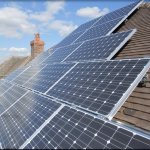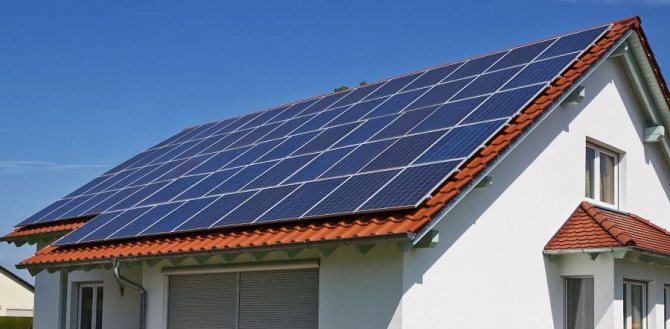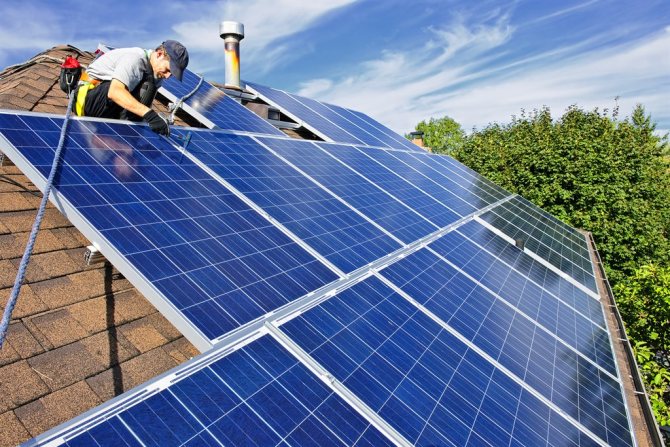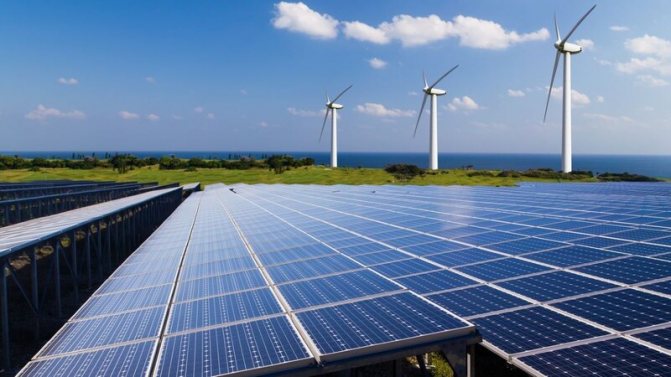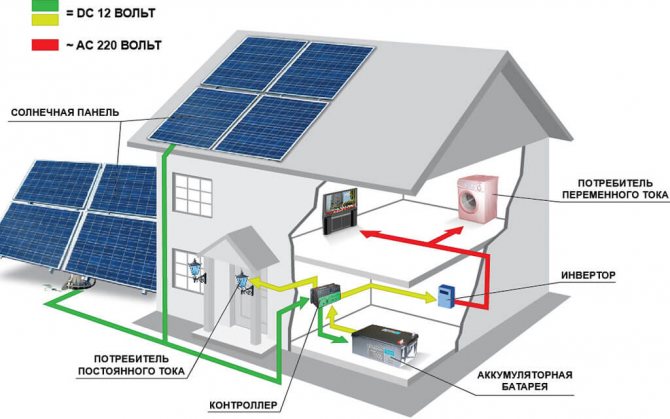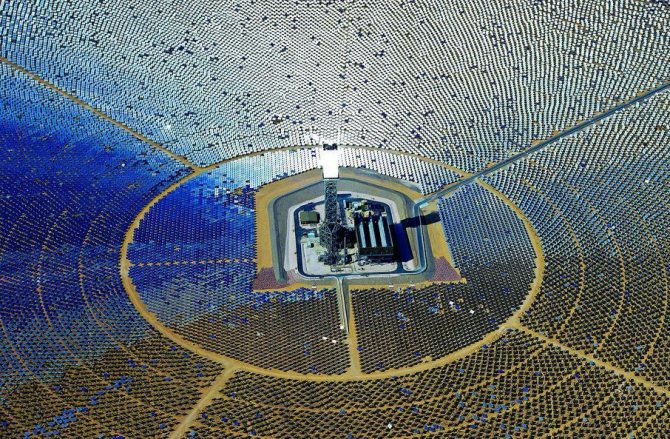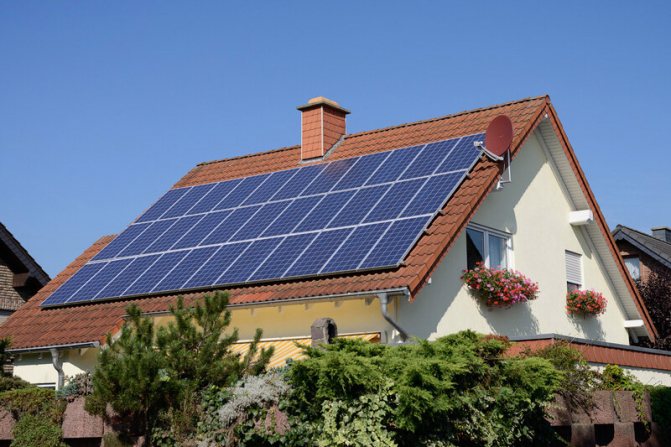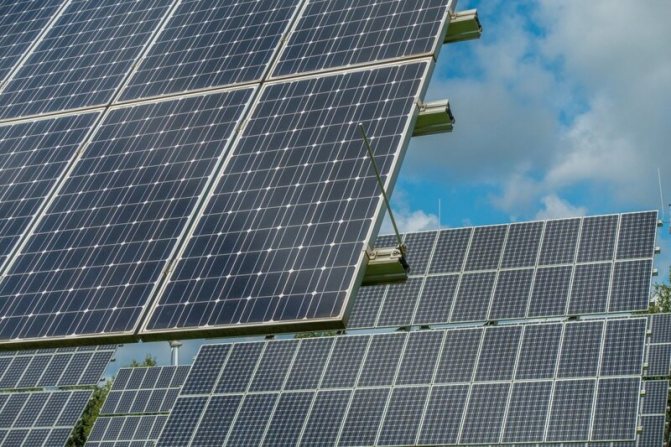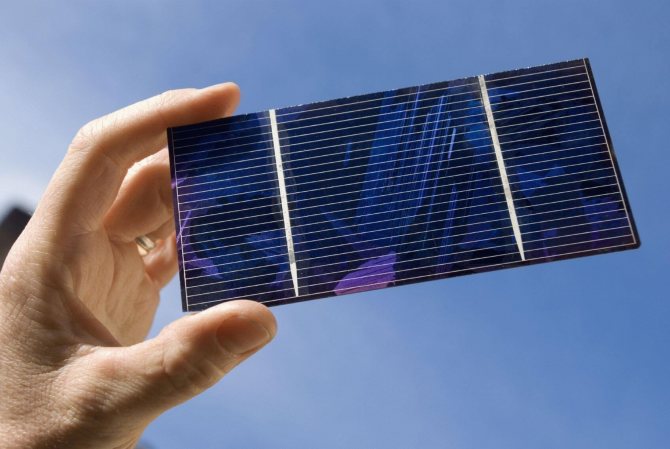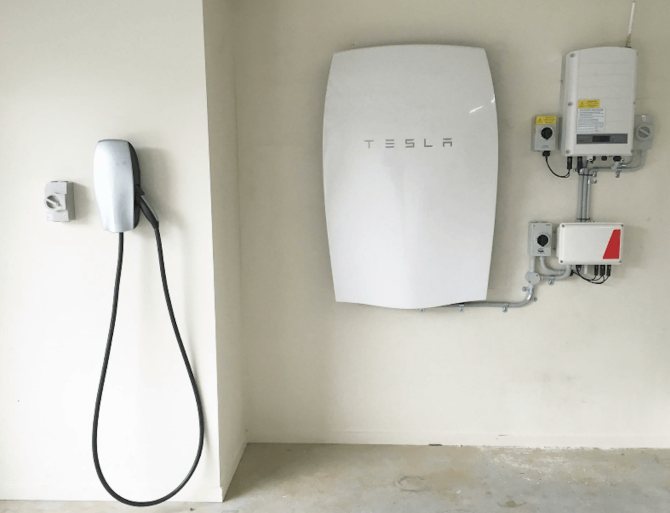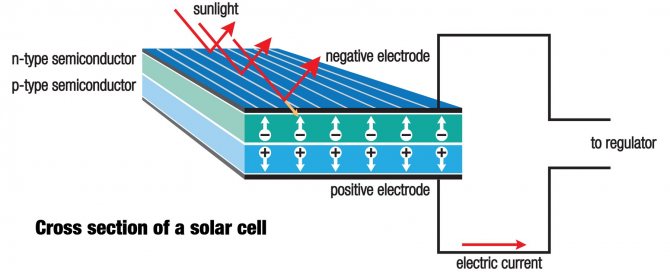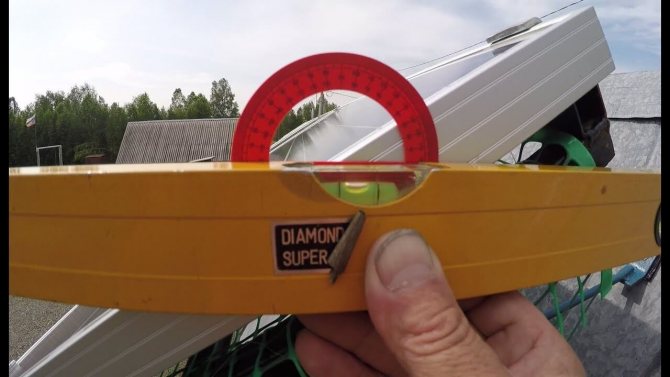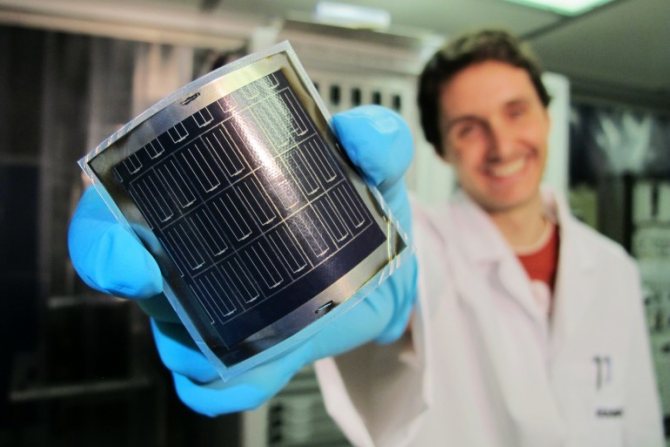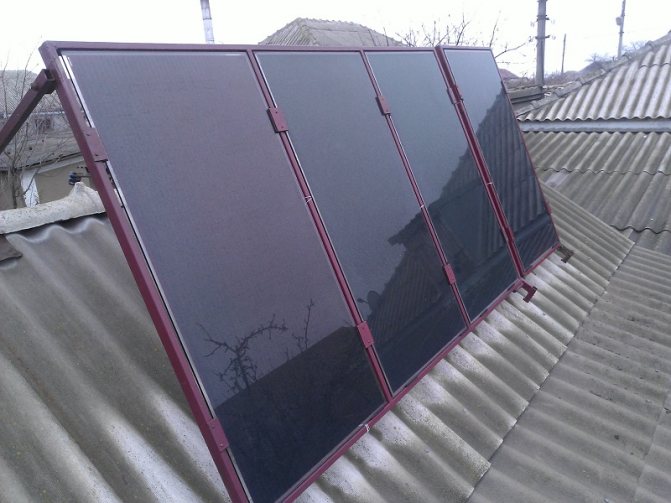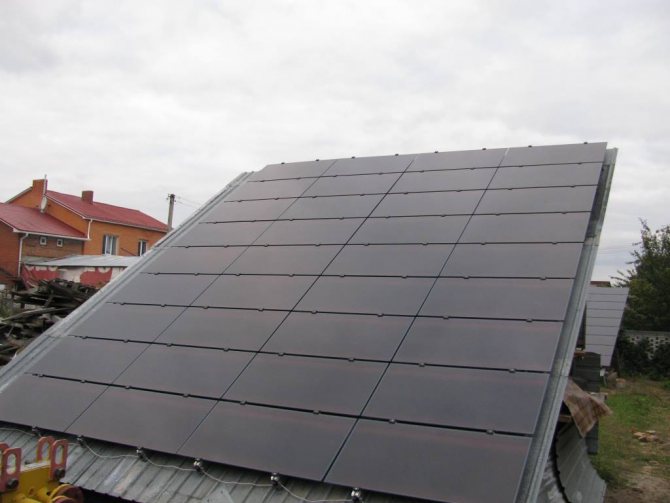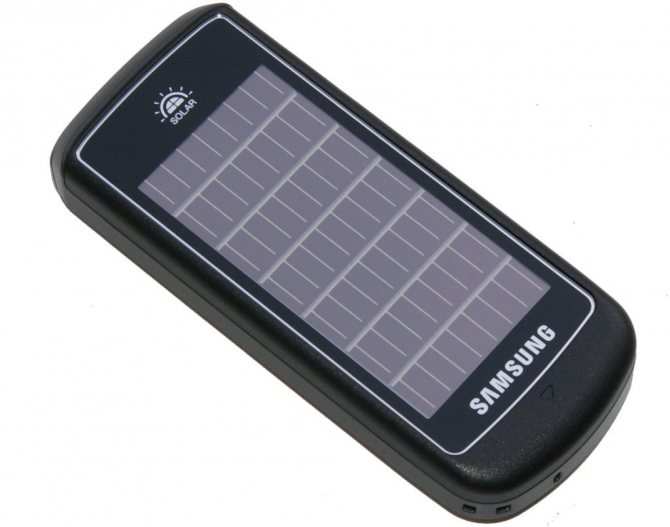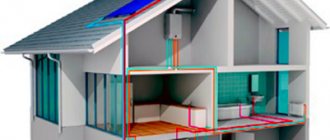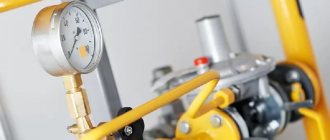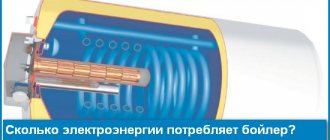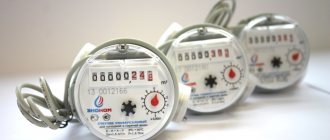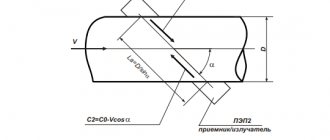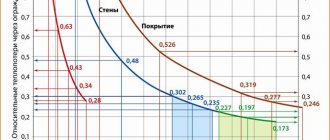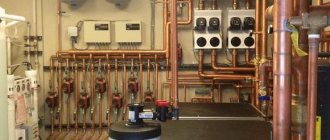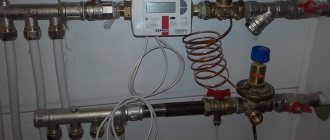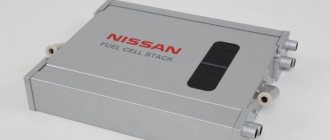Principle of operation
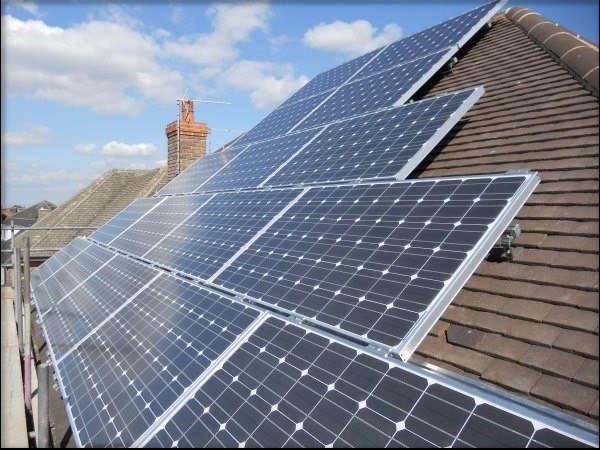
The design of many solar cells is made on the principle that they are, in the physical sense, photovoltaic converters. The power generating effect is manifested in the place of the “p – n” junction.
To concentrate solar energy in themselves, semiconductors are made in the form of panels. For this reason, these structures have received the same name, regardless of their shape (flexible or static) - solar panels.
What is the principle of solar panels and systems based on them? The panel includes 2 flint plates with distinguishable properties from each other. The process of generating electricity is as follows:
- Exposure to sunlight on the first leads to a lack of electrons.
- When exposed to the second plate, it receives an excess of electrons.
- Copper strips, conducting current, are connected to the plates.
- The strips are connected to voltage converters with built-in batteries.
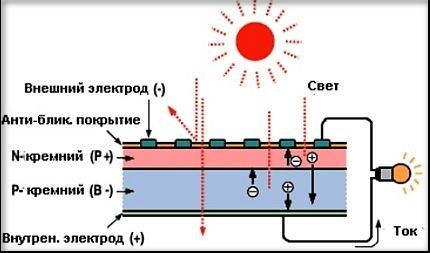

The base is silicon wafers. But in order to use this structure as an uninterruptible power supply (and not only during the solstice), not cheap batteries are connected to it (with their help, objects connected to the network consume energy at night).
In industry, the structure for absorbing solar energy is made of multiple laminated photovoltaic cells connected to each other and placed on a flexible or rigid support.
The efficiency of the structure is calculated based on the application of various factors. The main ones are the purity of the silicon involved and the placement of the crystals.
The process of purifying silicon is rather complicated, and it is not easy to arrange crystals in a single direction. The complexity of the processes responsible for increasing the efficiency translates into a high price for such equipment.
Solar panels are a promising direction in the energy sector, so billions of dollars are being invested in researching new projects in this area. PV conversion increases every quarter due to manipulation of conductors and structural elements. At the same time, not only silicon can be taken as a basis.
History of solar panels
People have been thinking about using the energy of the sun for a long time, but previously, technological capabilities did not allow it to be done. The starting point in this direction is the discovery of the photovoltaic effect in 1839 by the scientist A.E. Becquerel. They started talking seriously about the use of solar energy only in 1883, when the first module working on this source was invented. The prototypes were presented in France at the world exhibition, they focused the sun's rays with mirrors and reformed them into steam.
However, it took scientists several more decades to create solar panels capable of converting ray energy into electrical energy. The devices were cumbersome and ineffective. It was possible to achieve acceptable results in the 70s of the 20th century, but the devices were so expensive that they were used only in the space industry. The first solar panels for the home appeared by the 90s and every year their modification is constantly being improved.
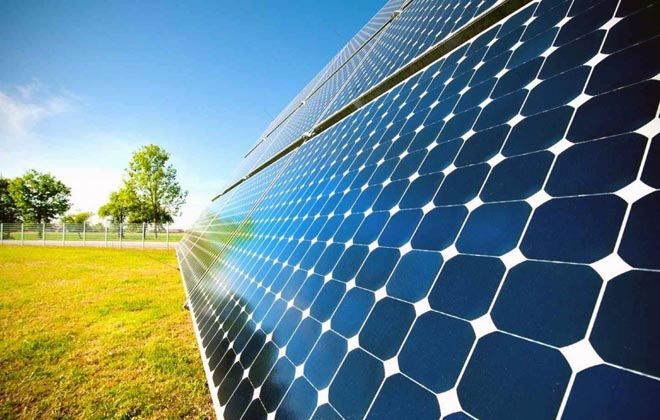

Types of photovoltaic converters
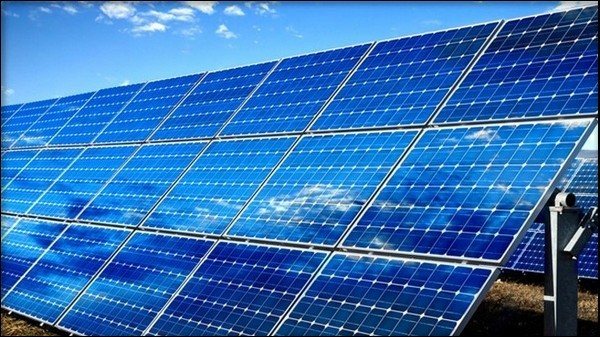

In industry, there is a classification of solar cells according to the type of device and the photovoltaic layer used.
By device they are divided into:
- panels from flexible elements, they are flexible;
- panels made of rigid elements.
When deploying panels, flexible thin-film ones are most often used.They are laid on the surface, ignoring some uneven elements, which makes this type of device more versatile.
By the type of photovoltaic layer for subsequent energy conversion, the panels are divided into:
- Silicon (single crystal, polycrystal, amorphous).
- Tellurium – cadmium.
- Polymeric.
- Organic.
- Arsenide – gallium.
- Indium selenide - copper - gallium.
Although there are many varieties, silicon and tellurium-cadmium solar panels have the lion's share in consumer turnover. These two types are chosen because of the efficiency / price ratio.
Monocrystalline converters
They are panels with beveled corners. Their color is always pure black.
If we talk about monocrystalline converters, then the principle of operation of a solar battery can be briefly described as medium efficient. All cells of the photosensitive elements of such a battery are directed in one direction.
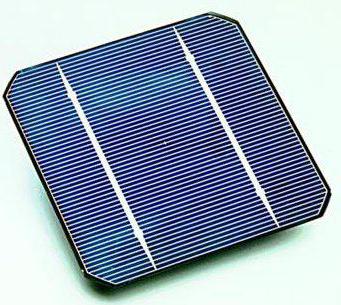

This allows you to get the highest result among similar systems. The efficiency of this type of battery reaches 25%.
The downside is that such panels should always be facing the sun.
If the sun is hiding behind clouds, sinking to the horizon, or has not yet had time to rise, then the batteries will generate a current of rather weak power.
Characteristics of silicon solar cells
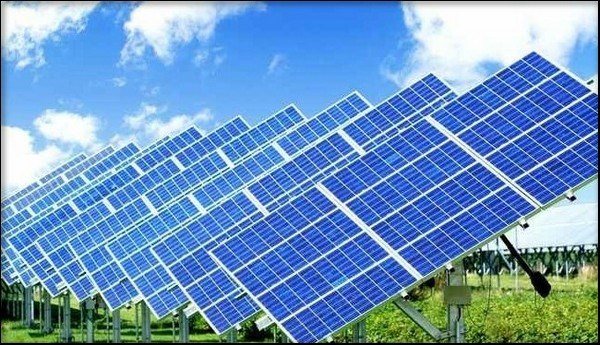

Quartz powder is a raw material for silicon. There is a lot of this material in the Urals and Siberia, therefore, it is silicon solar panels that are and will be in greater use than other subtypes.
Monocrystal
Monocrystalline wafers (mono – Si) contain a bluish – dark color, evenly distributed over the entire wafer. For such wafers, the most purified silicon is used. The cleaner it is, the higher the efficiency and the highest cost of solar panels on the market for such devices.
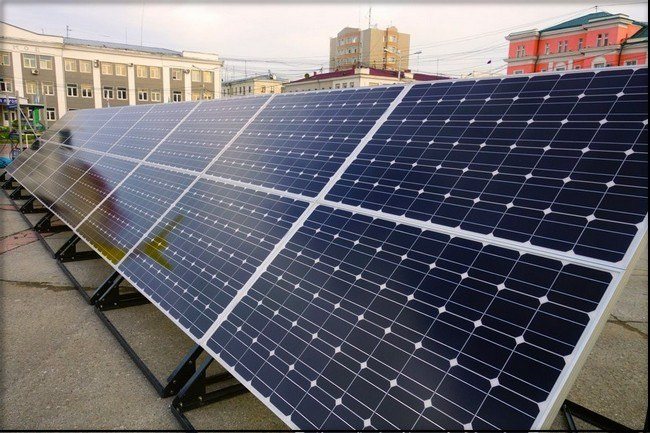

Single crystal advantages:
- Highest efficiency - 17-25%.
- Compactness - the use of a smaller area in comparison with polycrystal for the deployment of equipment in conditions of identical power.
- Wear resistance - uninterrupted operation of power generation without replacing main components is ensured for a quarter of a century.
Disadvantages:
- Sensitivity to dust and dirt - settled dust does not allow batteries to work with light from a luminary and, accordingly, reduces efficiency.
- The high price equals the increased payback period.
Since mono – Si require clear weather and sunlight, the panels are installed in open areas and raised to a height. As for the area, preference is given to areas in which clear weather is common, and the number of sunny days is close to the maximum.
Polycrystal
Polycrystalline plates (multi-Si) are endowed with an uneven blue color due to the multidirectional crystals. Silicon is not as pure as in the mono-Si used, so the efficiency is somewhat lower, along with the cost of such solar cells.
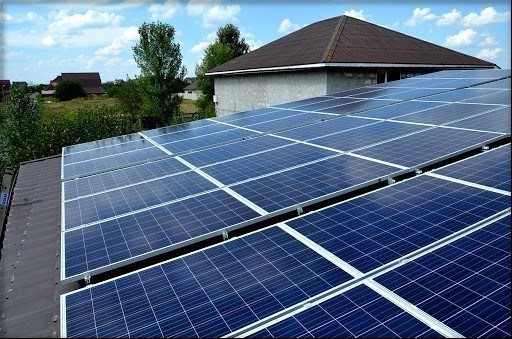

Positive Polycrystal Facts:
- The efficiency is 12–18%.
- In unfavorable weather, efficiency is better than that of Mono-Si.
- The price of this unit is less, and the payback period is much lower.
- Orientation to the sun is not critical, so you can place them on the roofs of various buildings.
- Duration of operation - the efficiency of energy absorption and storage of electricity drops to 20% after 20 years of continuous operation.
Disadvantages:
- The efficiency is reduced to 12–18%.
- Demanding to the place. A normal power generation plant requires more space to deploy than a single crystal battery.
Amorphous silicon
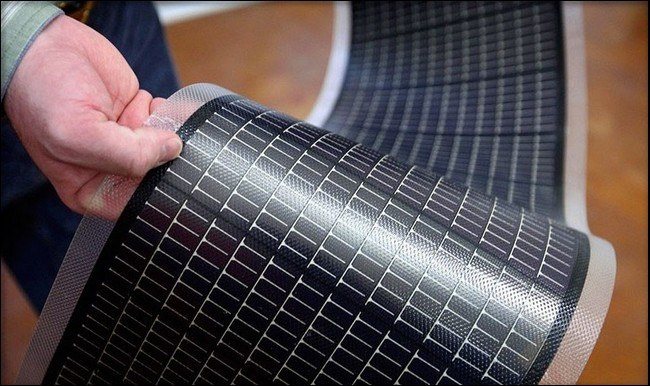

The panel production technology differs significantly from the previous two. Hot vapors are involved in the preparation, falling onto the substrate without the formation of crystals.At the same time, less production material is used and this is taken into account when determining the price.
Benefits:
- The efficiency is 8-9% in the second generation and up to 12% in the third.
- High efficiency in less sunny weather.
- Can be used on flexible modules.
- The efficiency of batteries does not drop down as the temperature rises, which allows them to be mounted on any surface with a non-standard shape.
The main disadvantage can be considered a lower efficiency (when compared with other analogs), and therefore requires a large area to obtain a comparable return from the equipment.
How to choose solar panels?
There is no definite answer which models are better, it all depends on many factors. When choosing a solar panel, you need to pay attention to the following points:
- Finance
... In order not to overpay, for home use, it is recommended to purchase a device with approximately 12 kW. - Power
... There are different offers on sale. Here it is necessary to take into account the number of electrical appliances and include a stock of 10-15%. - Carrier glass
... The photocell panel must be hidden under a hardened surface with mandatory lamination. The glass is inserted into the groove and secured with a sealant. - Profile material and thickness
... It must be a reliable supporting element with stiffening ribs. - Equipment
... In addition to the panels, you need to immediately purchase all the components to create a full-fledged network. - Mounting method and location
... You need to choose a place where there is the greatest intensity of sunlight from morning to noon. - Solar panels lifespan
... The indicator depends on the quality of the sealing of the material. The larger it is, the longer you should not worry about repairing and replacing equipment.
Portable solar panel
The popularity of using alternative methods of generating electricity has led to the emergence of portable devices. An improved solar panel is used to gain access to electricity without a grid. The choice of model is carried out depending on the requirements:
- A device with a storage capacity of 2-3 thousand mAh will be enough to recharge the phone's battery. Its weight is 300 g.
- Small household appliances or laptops can be supported by a model with an output current of at least 2500 mA. It looks like a fold-out bag made up of several interconnected panels. Weight up to 2 kg.
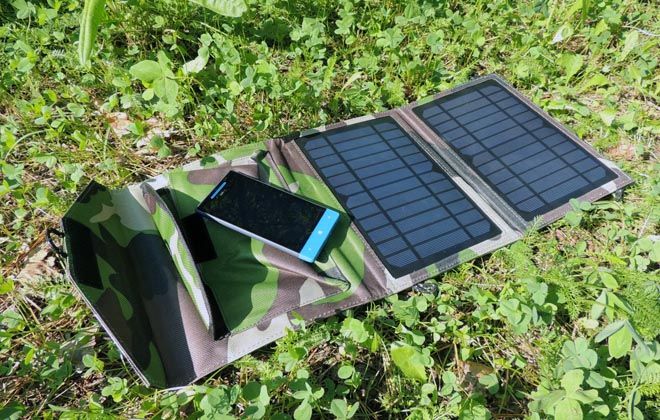

Overview of non-silicon modules
Solar panels made from more expensive analogs reach a coefficient of 30%; they can be several times more expensive than similar systems based on silicon. Some of them still have lower efficiency, while having the ability to work in an aggressive environment. For the manufacture of such panels, cadmium telluride is most often used. Other elements are also used, but less often.
Let's list the main advantages:
- High efficiency, from 25 to 35%, with the ability to reach, in relatively ideal conditions, even 40%.
- The photocells are stable even at temperatures up to 150 ° C.
- By concentrating the light from the luminary on a small panel, the water heat exchanger is powered, resulting in steam, which turns the turbine and generates electricity.
As we said earlier, the disadvantage is the high price, but in some cases they are the best solution. For example, in equatorial countries, where the surface of the modules can reach 80 ° C.
How to make a mini solar power plant
Now with Ali, a solar controller suits me
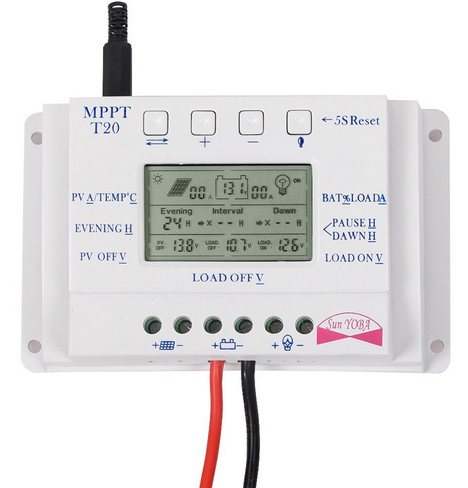

We will make a mini-power plant for our laboratory according to the classical scheme:
The blue box is the controller. The black box underneath is an inverter that converts the 12 Volts DC from the battery to 220 Volts AC (into the voltage at your home outlet). You already know the rest of the circuit.This circuit is completely self-contained and requires minimal maintenance.
Polymer and organic batteries
Modules based on polymer and organic materials have become widespread in the last 10 years, they are created in the form of film structures, the thickness of which rarely exceeds 1 mm. Their efficiency is close to 15%, and their cost is several times lower than their crystalline counterparts.
Benefits:
- Low production cost.
- Flexible (roll) format.
The disadvantage of panels made of these materials is the decrease in efficiency over a long distance. But this issue is still being researched and production is constantly being modernized to eliminate the disadvantages that may appear in the existing generation of this type of battery in 5-10 years.
How to connect a solar panel?
These devices are not finicky, they can be installed in any well-lit place on the roof, balcony or on the site. The main thing is to conduct the connection in such a way as to observe the angle of inclination from the horizon and the orientation of the location. Installation of solar panels requires high-quality anchorage at four points. This can be done using clamps or bolts. After that, all the components are connected in series. It is recommended to adhere to the following scheme:
- Connect the battery to the controller using a copper cable.
- Connect the photocell and the controller.
- Last of all, the inverter is connected to the battery.
How to make the right choice?
For home owners located on the European continent, the choice is quite simple - it is a polycrystal or a monocrystal made of silicon. At the same time, with limited areas, it is worth making a choice in favor of monocrystalline panels, and in the absence of such restrictions - in favor of polycrystalline batteries. When choosing a manufacturer, technical parameters of equipment and additional systems, it is worth contacting companies that are engaged in both the sale and installation of kits. Keep in mind that regardless of the manufacturer, the quality of the systems from the "top" manufacturers is unlikely to differ, so do not be fooled by studying the pricing policy.
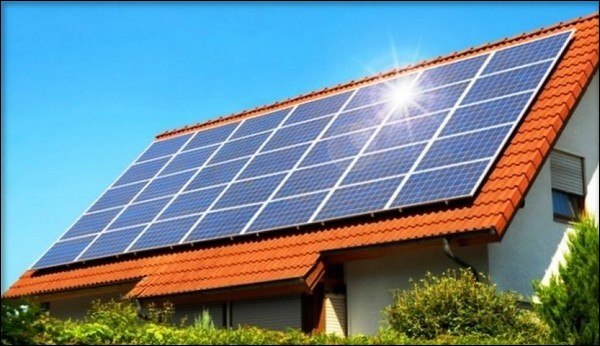

If you decide to order a turnkey installation of a "solar farm", keep in mind that the panels themselves in the package of such services will take only 1/3 of the total cost, and the payback will come close to about:
- A budgetary but effective choice will be panels from Amerisolar, the polycrystalline model is called AS-6P30 280W, has a size of 1640x992 mm and produces, respectively, 280 W of power. The module efficiency is 17.4%. Of the minuses - the warranty is only 2 years. But the cost is ∼7 thousand rubles.
- The RS 280 POLY module from the Chinese Runda will be similar in capacity, the cost is even lower - about 6 thousand rubles.
- If space is limited, you should pay attention to the product of LEAPTON SOLAR - LP72-375M PERC, the efficiency is 19.1%, and with dimensions 1960x992 mm we get 375 W of energy at the output. The cost of such a battery will be around 10 thousand rubles.
- Another effective option with smaller dimensions, 1686x1016 mm, will be a new product from LG - NeOn 340 W. "Not he" boasts an efficiency of 19.8%, but cannot boast of a cost, it will be more than half higher than the previous sample - about 16 thousand rubles ...
- For those who want to turn their attention to the premium segment, the Taiwanese company BenQ has launched the SunForte PM096B00 333W monocrystal module on the market, producing 333 W of power at the output, having a nominal efficiency of 20.4% with dimensions of 1559x1046 mm. This module received an impressive cost of almost 35 thousand rubles.
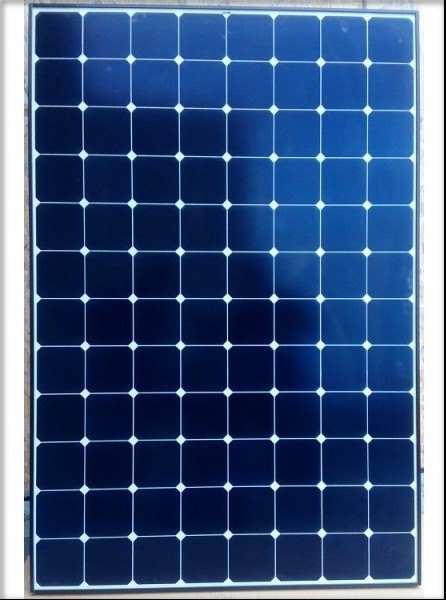

Components
The device itself and the principle of operation of the energy source can be called simple. It consists of only two parts:
- main building;
- conversion blocks.
In most cases, the body is made of plastic. It looks like an ordinary tile to which transducer blocks are attached.
The conversion unit is a silicon wafer. It can be made in two ways.:
- polycrystalline;
- monocrystalline.
The polycrystalline method is less expensive, and the single crystal method is considered the most effective.
All other additional parts (for example, controllers and inverters), gadgets and microcircuits are connected only to increase the efficiency and functioning of the energy source. The solar battery can also work without them.
Keep in mind: in order for this source to start functioning, it is necessary to correctly and accurately connect all the conversion units.
This article can help with calculating the power of solar panels:
There are two types of connection.:
- consistent;
- parallel.
The only difference is that in a parallel connection, an increase in current occurs, and in a series connection, the voltage increases.
If there is a need for maximum operation of two parameters at once, then parallel-serial is used.
But it should be borne in mind that high loads can cause some contacts to burn out. Diodes are used to prevent this.
One diode is capable of protecting one fourth of the photocell. If they are not in the device, then there is a high probability that the entire energy source will stop functioning after the first rain or hurricane.
An important point: neither the accumulation nor the current strength at all correspond to the possible parameters of modern household appliances, therefore, it is necessary to redistribute and accumulate electricity.
For this, it is recommended to additionally connect at least two batteries. One will be cumulative, and the second will be spare or reserve.
Let's give an example of the work of additional batteries. When the weather is good and sunny, the charge goes quickly and after a small amount of time, excess energy appears.
Therefore, this entire process is controlled by a special rheostat, which is able at a certain moment to transfer all unnecessary electricity into additional reserves.
You can get acquainted with the reviews of the owners of solar panels in this article:
Why is efficiency so important?
Efficiency gains great importance when calculating the area that you can use for a solar array system. With comparable sizes of the described modules from Amerisolar AS-6P30 280W (1.63 square meters) and NeOn 340 W from LG (1.71 square meters), the difference in power per square meter at the output will be 15.6%. On the one hand, this may not seem very effective, given the more than twice the price difference, but in the case of limited space or a more aggressive environment, it may shift your choice in favor of this well-known manufacturer.
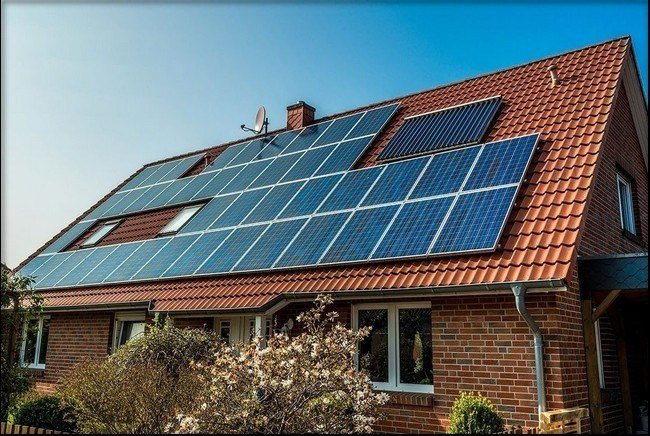

The increased efficiency emphasizes not only the efficiency of the manufacturing technology, but also the quality materials used in the manufacture. This can affect the life of the devices, the resistance of the panels to the so-called degradation. Do not forget also about the manufacturer's warranty obligations. With representative offices and warranty services in almost all corners of the world, LG will be able to boast of a more loyal approach to customers and fulfillment of its obligations.
Solar panels rating
The increasing demand for PV modules has led to the emergence of a huge number of new manufacturers on the market. It is difficult for an ordinary person to make the right choice in favor of a particular model. We offer you to get acquainted with the rating of the best solar panels:
- Trina Solar;
- Jinko Solar;
- Canadian Solar;
- Seraphim;
- JA Solar;
- Panasonic;
- SunTech;
- LONGi Solar;
- ABi-Solar;
- Risen Solar.
Regardless of the fact that Russian-made solar panels have not yet entered the list of the best, they are produced in large quantities and are gradually conquering the market at home. Each buyer individually decides which company to choose. It can be a domestic manufacturer or a foreign one, it all depends on the financial condition and the emerging requirements.

